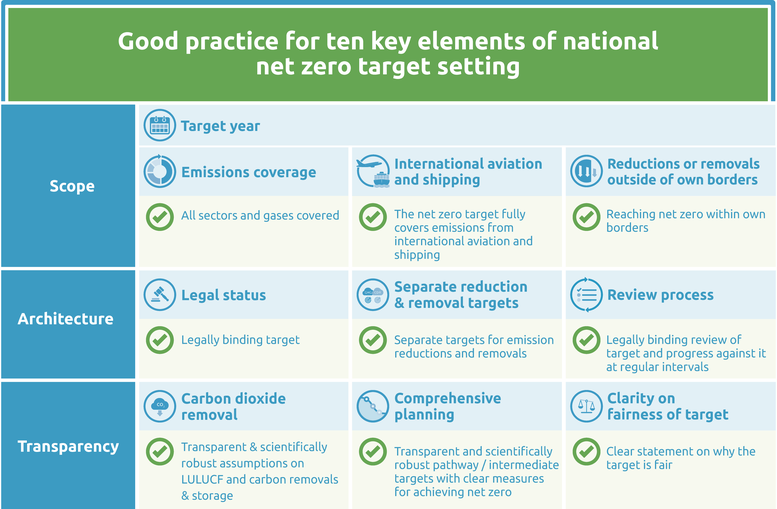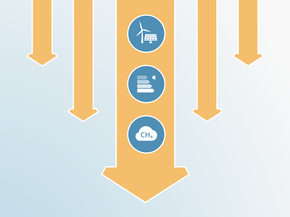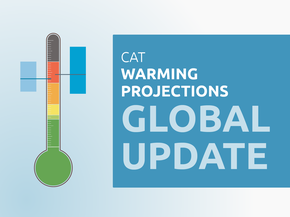Net zero targets
Summary
We rate the net zero target as: Average
Peru has committed to reaching net zero by 2050. A net zero by 2050 target was included in Peru’s first NDC, and the Ministry of Environment (MINAM) explicitly set the 2050 target in a 2024 decree which approved Peru’s “Estrategia Nacional ante el Cambio Climático al 2050”[National Climate Change Strategy to 2050] (ENCC). The ENCC was submitted to the UNFCCC as Peru’s long-term strategy in June 2025.
The decree, however, does not include an absolute emissions level to be reached by 2050. The ENCC includes actions and indicators to reach net zero emissions by 2050 and meets many of the 10 key elements of national net zero target setting identified by the CAT as good practices. The Strategy communicates strategic goals and policy initiatives at the national and sectoral level, however it does not clarify specific pathways for LULUCF and removals, which are provided in an earlier government-endorsed report (Quirós-Tortos et al., 2021). Peru has an established, legal review process for the implementation of the ENCC.
The quantitative assessment of Peru’s net zero target considers the “carbon neutrality” scenario presented in the report “Costos y beneficios de la carbono-neutralidad en Perú” (Quirós-Tortos et al., 2021). According to this document, produced by the Interamerican Development Bank for MINAM, “carbon-neutrality” is understood to cover all gases and will be achieved through reductions in sectoral emissions in combination with LULUCF sinks. This scenario gives an absolute emissions level and corresponding LULUCF sink level for 2050. In order to achieve this, Peru must first rapidly shrink its LULUCF emissions.
Ten key elements
Scope
- Target year – Peru aims to reach net zero by 2050.
- Emissions coverage – The target covers all GHG emissions (i.e., the 7 Kyoto gases: CO2, CH4, N2O, HFCs, PFCs, SF6, NF3) and all sectors of the economy (excluding international bunkers).
- International aviation and shipping – Peru provides no information on its intention to cover international aviation and shipping.
- Reductions or removals outside of own borders – Peru does not actively outline any plans to rely on reductions or removals outside its borders. Neither Peru’s NDC nor its underlying pathways towards 2050 explicitly rule out international credits.
Target architecture
- Legal status –
- Peru included its net zero target in its updated NDC in 2020. The government updated its National Climate Change Strategy to 2050 in late 2024, which includes a net zero emissions target by 2050 (MINAM, 2025). The National Climate Change Strategy to 2050 and net zero target were approved by Supreme Decree (MINAM, 2024).
- The net zero target is included in Peru’s LTS (MINAM, 2025).
- Separate reduction & removal targets – Peru has not officially communicated separate emission reduction and removal targets, although Government-endorsed analyses that are referenced in the strategy provide information on LULUCF contributions.
- Review process – Peru has a legally binding process in place to review the overall implementation of the National Climate Change Strategy to 2050 and progress towards the net zero target.
Transparency
- Carbon dioxide removal – Peru does not provide transparent assumptions on carbon dioxide removals in the National Climate Change Strategy to 2050.
- Comprehensive planning – Peru provides analysis including sectoral policies and initiatives to achieve net zero in the National Climate Change Strategy to 2050 (ENCC) including designating responsible agencies and actors. The ENCC includes general initiatives, for example reducing emissions from enteric fermentation or from road freight transport, but tends to lack detail on specific levers to reduce emissions. The sectoral emissions pathways outlined in the ENCC come from government-endorsed analysis in a separate report that includes sectoral emissions pathways to reach net zero emissions by 2050.
- Clarity on fairness of target – Peru makes no reference to fairness or equity in the context of its net zero target in the climate change strategy.
Good practice
The Climate Action Tracker has defined the following good practice for all ten key elements of net zero targets. Countries can refer to this good practice to design or enhance their net zero targets.

Further analysis
Latest publications
Stay informed
Subscribe to our newsletter




